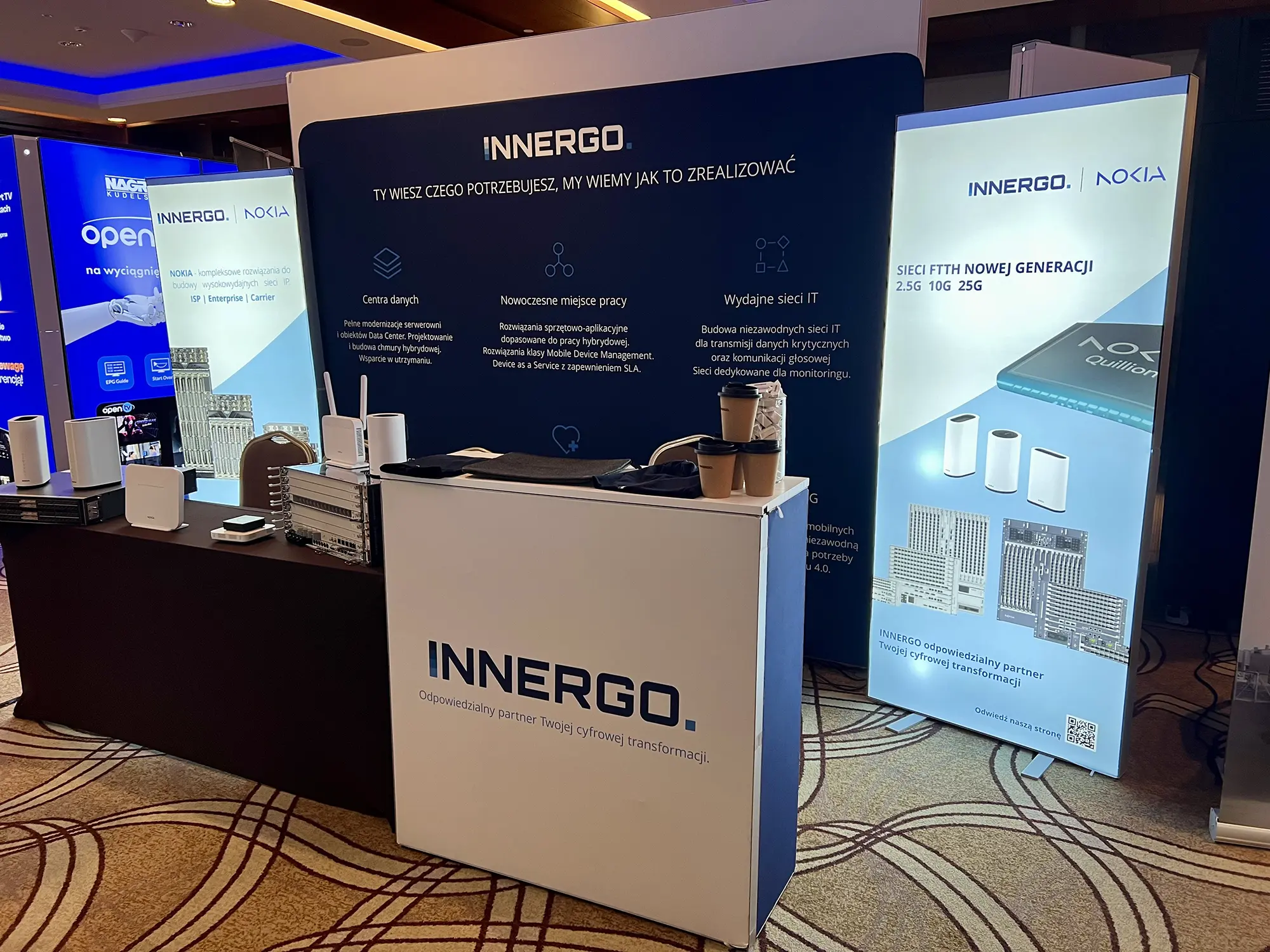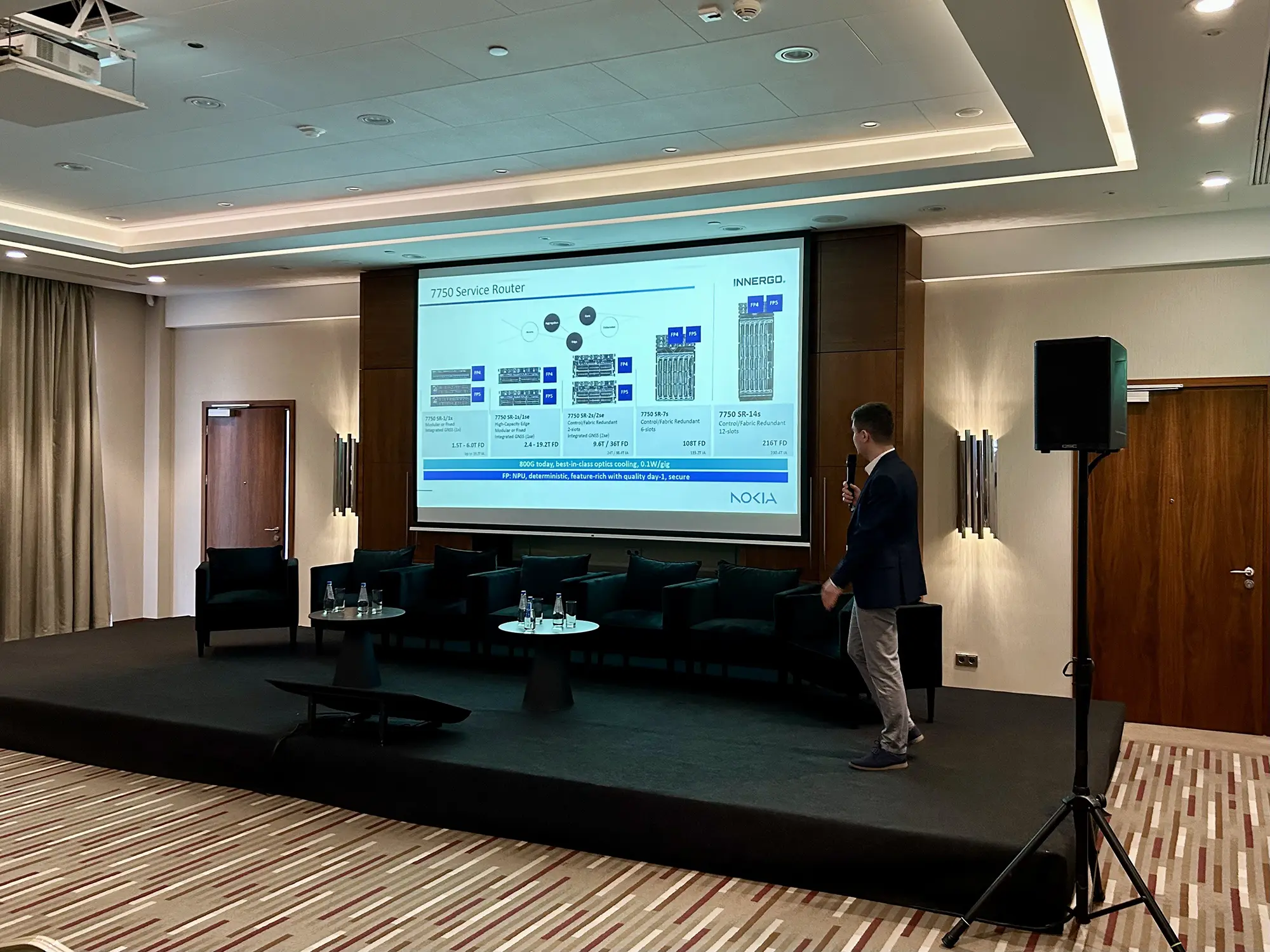

The autumn conference of KIKE (National Chamber of Ethernet Communication), held on October 27-29 in Warsaw, brought together operators, technology providers, and integrators to discuss topics that directly affect the daily operations of ISPs: infrastructure security, new regulations, digital transformation, and competence development in local telecommunications networks. The market is becoming increasingly demanding, and operators are looking for proven, secure, and future-proof solutions that not only meet current requirements but will also be ready for the changes that await operators in the future.
In this environment, INNERGO appeared not only as an exhibitor, but above all as a project partner for operators. The presentation of Nokia’s solutions during the conference session and the joint INNERGO + Nokia stand were aimed at showcasing the latest capabilities and, at the same time, encouraging operators to ask themselves: “Is my IP network ready for growth, new services, and security requirements—without replacing everything from scratch?”
Why did we define the needs and expectations of the market in this way? Experience from the development of the Polish operator market allows us to characterize the activities of an ISP operator that is developing an FTTH/XGS-PON network and access, while at the same time recording increasing traffic volumes (video, gaming, remote work), which would seem to be a good forecast for the operator’s business. However, it is important to remember the increasingly stringent requirements for security and quality (and therefore the ongoing updating/modernization of infrastructure in this regard), which, combined with growing network and traffic demands, may in practice lead to the need to replace infrastructure every 3-4 years.
This is not a good scenario from an economic point of view. The Nokia solutions we offer allow you to avoid this necessity, ensuring smooth development and scaling of once purchased and installed equipment, even with a significant increase in traffic requirements or significant configuration changes.
INNERGO x Nokia booth – complete solutions for ISP networks
At the joint INNERGO and Nokia stand, operator representatives had the opportunity to familiarize themselves with devices for use in their networks. It was a very practical demonstration of solutions that are primarily associated with large, global implementations, but thanks to the use of appropriate configuration, licensing, and development models, they can also be made available to smaller, local operators. Devices from two technological branches were presented:
Nokia 7750 Service Router (SR) – carrier-class IP/MPLS platform:
- applications: BNG, edge, core, peering/transit, CG-NAT, DCI, service nodes,
- high scalability of bandwidth and number of sessions,
- preparation for 100/400/800G in the same hardware ecosystem.
FTTH/XGS-PON access solutions:
- OLTs as aggregation nodes,
- ONT as subscriber devices,
- full integration with the IP layer 7750 SR – end-to-end from the customer to the core.
Discussions at the stand revealed the considerable maturity of the Polish ISP market and the high level of awareness among operators, who typically did not just ask about devices, but wanted to talk about solution architecture, migration scenarios, models for phased replacement and development of existing networks, and possibilities for automating their configuration and maintenance. These needs correspond well with the possibilities offered to operators by Nokia solutions that meet all of the above expectations.


INNERGO presentation: Nokia’s multifunctional IP platforms for operators
During the conference, Krzysztof Pyko, an expert at INNERGO, presented a practical approach to building an ISP IP network based on Nokia 7750 SR family solutions, expanding on the message contained in the title of his presentation: “Edge, peering, BNG, or maybe CG-NAT? It doesn’t matter to Nokia SR”. To summarize the entire message in one sentence, it can be said that the same hardware platform can perform different roles, depending on the current needs of the operator, and not on the limitations of the devices – investing in Nokia SR solutions is always safe, because Nokia 7750 SR routers can change (through reconfiguration or expansion) along with changing needs, changes in network topology and configuration, and other technical and business conditions. This is determined, among other things, by the following features of the solution:
Architectural flexibility
One family of 7750 SR devices (SR-1/1x, SR-2s/2se, SR-7s/14s) enables the construction of a complete architecture (access/aggregation, edge and BNG, core and peering, nodes for CG-NAT and VAS services). At the same time, instead of multiple distributed platforms, we have homogeneous management – a consistent operating system, configuration model, easier maintenance, and automation capabilities.
Specialized FP5 chipset: performance and security
This solution has been designed and built specifically for hundreds of gigabits per slot throughput and 800GE support, as well as extensive QoS mechanisms (H-QoS, hundreds of thousands of queues), DDoS mitigation, and ANYsec/MACsec. All this while maintaining optimal energy efficiency. In practice, for ISPs, this means the ability to serve a growing number of customers and services without the risk of overloading and “choking” the router, while ensuring that security and quality requirements are met.
Port satellites: effective use of valuable interfaces
The concept of “satellites” (e.g., 7210 SAS, 7250 IXR) allows ports 1–100G to be ‘moved’ outside the main 7750 chassis, avoiding the “waste” of 100/400G ports on low throughputs and managing everything from a single router (one OS, one configuration). This also translates into savings, as it means simpler POP design, easier segmentation, and consequently lower CAPEX/OPEX costs for the operator.
End-to-end: from OLT to core on a single network logic
The combination of OLT/ONT for FTTH/XGS-PON and 7750 SR routers as BNG, traffic aggregators, and core allows you to create a consistent environment where it is easier to control QoS with subscriber/service accuracy, implement premium services, and ensure compliance with security requirements.
Modularity and investment protection
XMA/XMA2 cards and a properly prepared licensing model allow you to start providing services with lower bandwidth and gradually increase it as needed. At the same time, you can smoothly increase functionality (e.g., HE/ER) by adding licenses, without replacing all equipment, and select interfaces (10/25/100/400/800G) according to the actual increase in traffic. This significantly reduces the risk of overinvestment and allows you to make the best use of the operator’s financial resources.

Practical examples – scenarios for operators
Implementation experiences were also presented, along with a discussion of two examples of recent installations:
Deutsche Glasfaser
The project included the delivery of the entire IP network with the replacement of the existing infrastructure in terms of access, edge, BNG, and backbone routers, along with service. In addition to 7750 SR devices (access, aggregation, BNG, core, peering), an NSP system was also implemented in the form of an automation framework, overseeing both Nokia routers and part of the older IP infrastructure.
Try&Buy scenario at one of the ISP operators in Poland
In order to expand the operator’s infrastructure, an additional BNG node with NAT was designed, built on 7750 SR-1x with 400G ports and the possibility of a smooth transition to 800G and expansion via satellites – as an example of how to test a new platform in a production environment in stages and safely.
These examples illustrate a model that can be applied to any growing ISP. The key benefits of this approach are:
- step-by-step migration,
- the possibility of parallel operation of the old and new infrastructure,
- rapid verification of solutions in production conditions.
Conclusions for local ISPs
- It is worth investing in a single, scalable IP platform instead of a mosaic of different devices with limited roles.
- The flexibility of the 7750 SR + FP5 + satellites allows you to build a network that grows with your business—instead of forcing costly, sudden expansions.
- Integration with FTTH/XGS-PON access facilitates the offering of differentiated services (B2C, B2B, critical services) without compromising QoS and security.
Cooperation with an integrator such as INNERGO provides access not only to hardware, but also (and perhaps most importantly) to architecture design, migration scenarios, automation capabilities (NSP), and implementation and service support. The services we can offer in these areas include:
- audit of the readiness of the current IP/BNG network to accommodate growing traffic and territorial expansion,
- architecture design based on Nokia 7750 SR routers (edge/core/BNG/peering/CG-NAT),
- selection and implementation of access solutions (OLT/ONT),
- Try&Buy and phased migration scenarios, without risk to production services,
- support in automation (NSP) and integration with the operator’s existing environment.
Summary
INNERGO’s presence at the KIKE conference was well suited to the theme of the event: security, new regulatory requirements, growing traffic volumes, and the need for automation (as these were the main topics of the conference). Network architecture based on Nokia SR solutions combined with INNERGO’s integration services is a good response to these requirements of the growing operator market.





